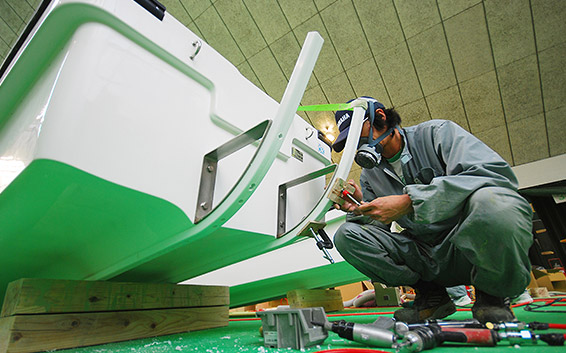On March 11, 2011, the largest earthquake ever recorded in the vicinity of Japan (magnitude 9.0) occurred on the ocean floor southeast of Miyagi Prefecture, triggering the Great East Japan Earthquake and Tsunami that struck the country’s northeastern seaboard. The resulting tsunami hit the Pacific coast with a massive wall of water over ten meters high, spreading devastation along the coastal areas of the Tohoku and Kanto regions. The destruction was unprecedented; the total number of deceased and missing persons exceeded 18,000, while approximately 400,000 buildings were either partially or completely destroyed.
The disaster also destroyed most of the estimated 20,000 utility boats in operation in the coastal areas of the Tohoku and Kanto regions, with only about 1,000 left intact or repairable. This was a crushing blow to the region’s coastal fishing industry.

To get new boats to the fishermen in stricken areas as quickly as possible, the Japanese government’s Fisheries Agency responded by launching a “Joint-use Fishing Boat Construction Support Project,” with Yamaha Motor agreeing to manufacture 4,000 utility boats by March 2013. However, the previous year, Yamaha Motor had produced no more than approximately 250 fishing boats and utility boats, so producing 4,000 boats meant that a major boost in manufacturing capacity was required (further orders brought the total to 4,900). To meet its quota, the company quickly set to work in preparing for greater production with measures like investing in production facilities with more FRP-boat molds and jigging tools, and recruiting additional boat production workers—often from retired YMC personnel—and boat builders from the stricken areas.

Another difficult task was the rigging of the newly constructed boats. Normally, fishing boats and utility boats are not used as they are when shipped from the factory, and undergo a final rigging at the local boat dealerships to specifications that fit the different local fishing methods. However, the local dealerships in the stricken areas had also suffered significant damage, so there was no way that they alone could rig 4,000 boats. That reality prompted Yamaha to set up a temporary rigging center in an indoor tennis court facility at its Sportsland SUGO international racing circuit and man it with more than twenty full-time employees experienced in rigging work. Many of these employees were recruited from the areas hit by the earthquake and tsunami, but there were also a number from distant parts of the country who came to help after seeing media broadcasts.


As work efficiency increased at the rigging center, the pace reached a steady output of ten boats a day, which were then transported to the local dealerships in the stricken areas. In this way, the planned increase in production and rigging of boats continued, and the temporary rigging facility at SUGO that had served as the driving force of the project finally fulfilled its role in August 2013. The increase in utility and fishing boat production made necessary by the Great East Japan Earthquake and Tsunami still continues today in 2015, but the rigging operations have returned to the local dealerships as they were before the disaster, proof that the fishing industry of the Tohoku region is making its way to recovery step by step.
.










